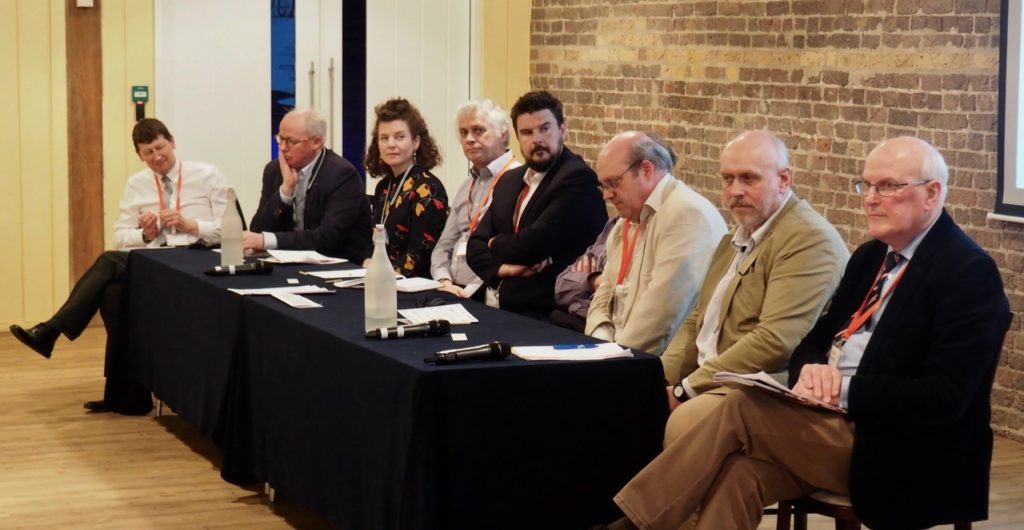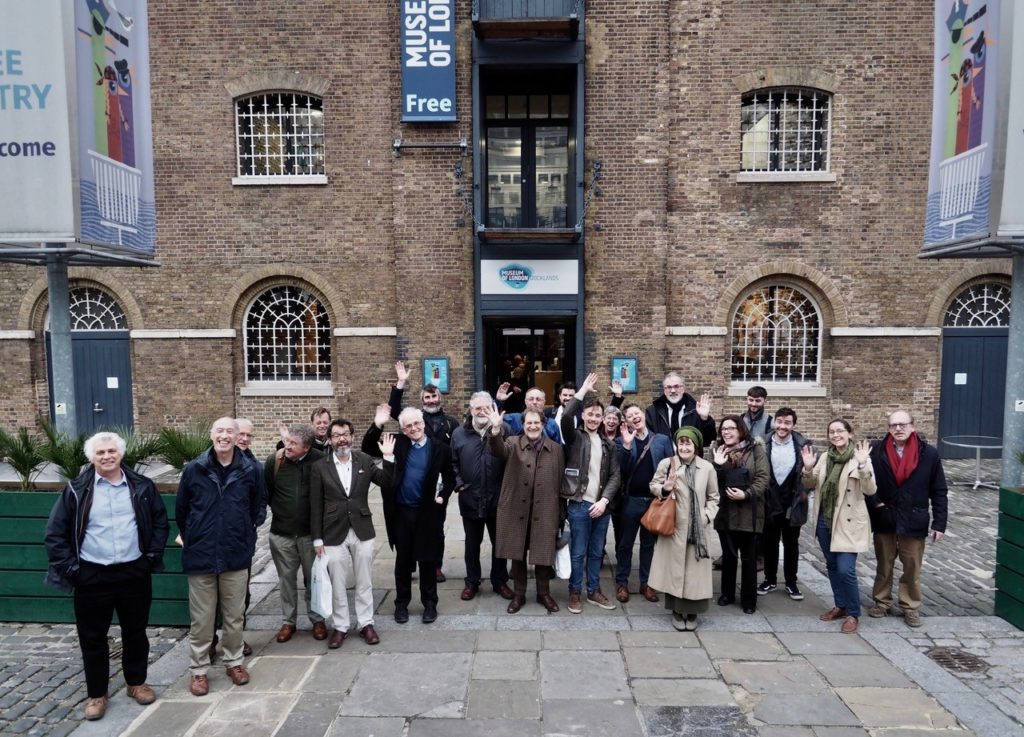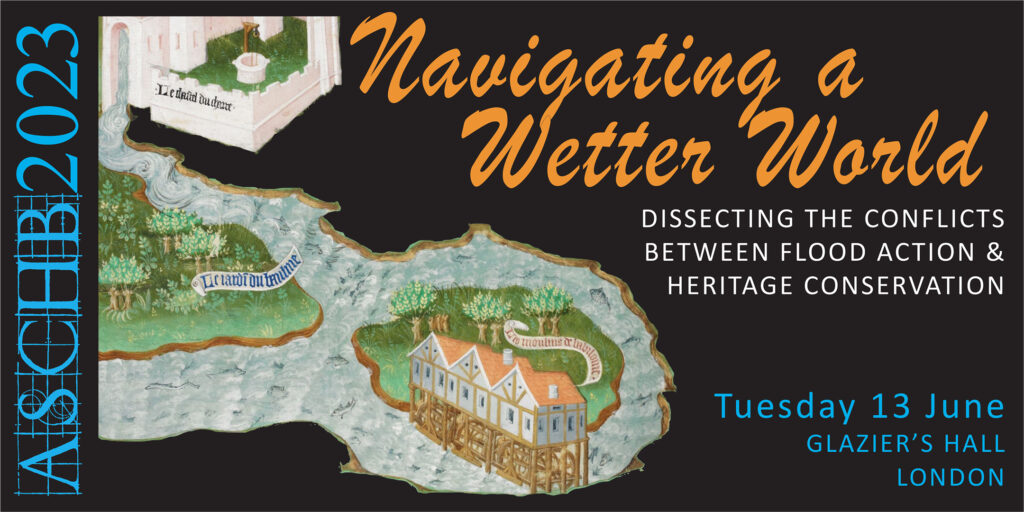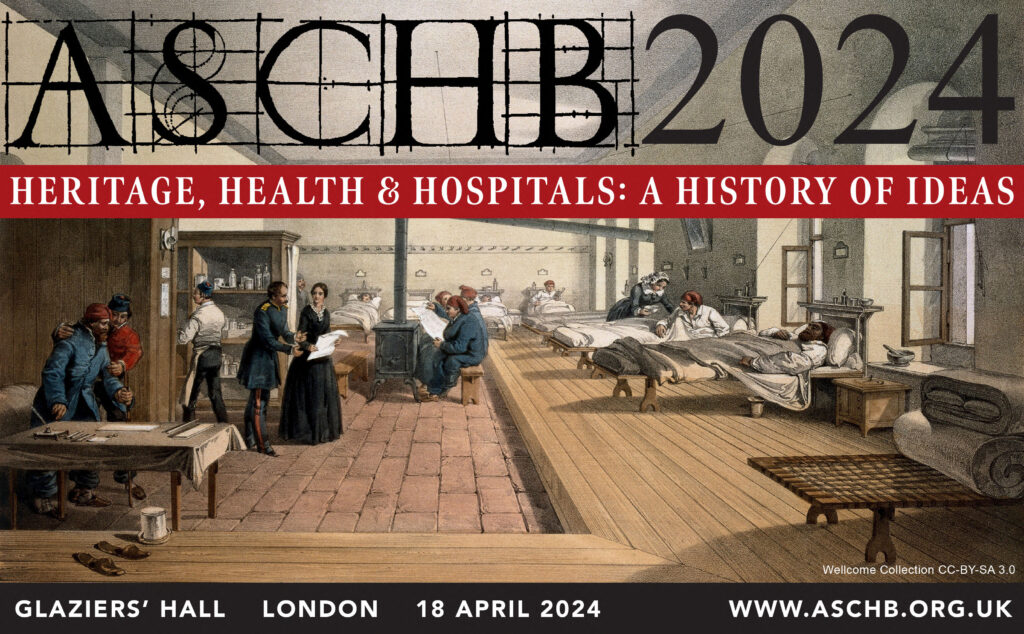

ASCHB CONFERENCES
ASCHB 2024 CONFERENCE
Intending to come but not confirmed yet? Please go to CONTACT page, select ASCHB2024 Conference from the ‘I am interested in’ dropdown and tell us you will be joining us on the day.
Thursday April 18 2024
GLAZIERS’ HALL
9 Montague Place
London Bridge
SE1 9DD
As with so many aspects of our lives, healthcare changed radically as a result of the Industrial Revolution and the Enlightenment thinking which it triggered. Some changes were of immense value, but others came with unfortunate consequences. ASCHB2024 turns the microscope onto the built environment and healthcare, looking at the impacts of science and fashion on hospitals and other healthcare buildings, and asking: what are we doing right, and where have we gone off the rails? How can we extract the best ideas from the whole history of healthcare in the built environment, to construct a better and healthier future?
Registration will be from 8:30 – 9:15am
The conference will be opened by the ASCHB Chairman, Sherry Bates, at 9:15am. We will break for morning tea at 11.00am, lunch at 12:30 – 1:30pm and afternoon tea around 3:15pm. The conference will close at 5:00pm.
We have a great line-up of speakers: the day is divided into three broad themes: past, present and future.
Part 1 KNOWLEDGE FROM THE PAST
- Jelena Bekvalac, Curator of Human Osteology at the Museum of London
What we really know about health in the past: “Cancer, diabetes, dementia.. We think of these diseases as scourges of modern industrial living, but have they always existed undetected in humans? Do we have genetic predispositions to such conditions? The archive of human skeletal remains at the Museum of London provides a large bank of evidence to investigate how far some of these diseases go back in time.”
- Dr Michael Carter, Senior Properties Historian at English Heritage
Medieval Monasteries and public health: “How different things were in earlier centuries when life, according to the old adage, was “nasty, brutish and short”. But despite what Blackadder, Monty Python and countless HistoryChannel documentaries would have you believe, our medieval ancestors weren’t stupid. Nor were they entirely helpless in the face of illness and disease. As was so often the case, monasteries were at the forefront, providing both physical and spiritual healing.”
- India Wright, University of Cambridge doctoral candidate and Trustee of the Construction History Society
Spas and health: “We know much about the major spas at Bath and Tunbridge Wells which catered for the wealthy elite, but what of the lesser spas which sprang up in the late seventeenth century to be frequented by ordinary people?… [what do their structures] divulge of the health and social rituals of the time?”
- Dr Clare Hickman, Senior lecturer in history at Newcastle University and author of The Doctor’s Garden:
Medicine, Science, and Horticulture in Britain: Health care and gardens in the 19th century and beyond: “As Britain grew into an ever-expanding empire during the late 18th and early 19th centuries, new and exotic botanical specimens began to arrive within the nation’s public and private spaces. Gardens became sites not just of leisure, sport, and aesthetic enjoyment, but also of scientific inquiry and knowledge dissemination.”
- Dr Robyn Pender, director at Whethergauge
How ideas of comfort and health have changed across history: “Our thermoregulatory systems become moribund if they are not exercised… In other words, the more we live and work in tightly controlled thermal conditions, the more apt we are to feel uncomfortable; or worse, to suffer serious health problems from exposure to very hot or very cold conditions.”
Part 2 WHAT WE ARE DOING NOW: CASE STUDIES
- Will Palin, CEO of Barts Heritage Trust
Waking a Sleeping Giant: The Rescue and Repair of the North Wing at St Bartholomew’s Hospital: “The North Wing with the Great Hall and Hogarth Stair, and the Henry VIII Gate, are among the most important, yet largely unrecognised, buildings in the City of London, and… the project to return them to their former glory [allows] everyone to see and understand their importance in the life of the oldest hospital in Britain.”
- Fiona Lamb, Director at Avanti Architects
Finsbury Health Centre: “Avanti is thrilled to finally be undertaking the next phase of conservation work at Finsbury Health Centre, a project we started over 25 years ago. The phased works… will help secure this deeply loved resource for its local community.”
- Ian Fleetwood, Senior Designer at HOK
The importance of the landscape at the new Royal Papworth Hospital: The park-like setting on the Cambridge Biomedical Campus features green spaces organised around a duck pond (a cherished feature from the old location) that provides patients, family and staff a link to nature that aids in the healing process. Unfortunately Kirstin Ziemer is unable to join us due to unforeseen circumstances.
- Siobhan Wyatt, Director of Property at Maggie’s Centres
Maggie’s Centres: The Maggie’s Centres are a network of drop-in centres located near existing hospitals in theUK and Hong Kong, founded by the late Maggie Keswick Jencks, who died of cancer in 1995. Like her husband, architectural writer and critic Charles Jencks, she believed in the ability of buildings to uplift people.
Part 3 WHAT DO WE NEED TO CHANGE FOR THE FUTURE?
1O. ENDNOTE: C Alan Short, Professor of Architecture at Cambridge University and President of Clare Hall
Alan Short is the author of The Recovery of Natural Environments in Architecture. He argues persuasively that architects must look at how their predecessors designed for a wide range of climatic conditions before the invention of ‘artificial weather’. His extensive research on historic naturally ventilated buildings aims to re-establish a common thread of learning that was abruptly cut by Willis Carrier’s application of mechanical air conditioning in the early 20th century.
Alan and his team have a long background in investigating the links between buildings and health, and lead the UK AHRC project ‘Excising Infection in Surgical Environments’, which focused on the design of operating theatres. His research group has produced a film of its work on the NHS Estate, ‘Robust Hospitals in a Changing Climate’, which won the tv/e Global Sustainability Film Award 2013 at the BAFTA. During the COVID-19 pandemic, Alan worked as part of a small team on ‘Making Emergency Hospitals Safer’, and sat on the SAGE-EMG group advising DCMS on the reopening of theatres (of the non-medical kind!). He also co-authored a report on UK infrastructure’s resilience to infection that was published by the National Engineering Policy Centre (NEPC). The risk of airborne cross-infection is now taken much more seriously.
Alan was appointed to administer and monitor the NHS Energy Efficiency Fund 2013-14 with the Professor of Sustainable Engineering Peter Guthrie, reporting to the Under Secretary of State for Health, and his team has redrafted the guidance on energy efficiency for the NHS.
PLENARY: Weaving old and new into a better future for health
Given the wealth of information we have shared over the course of the day, and our own professional knowledge, of where the problems and the opportunities lie, how can we continue to integrate the deep knowledge from heritage with modern medical practice and construction? Our speakers share the stage to discuss these questions with each other and the audience.
Michael Beare, our current ASCHB President, will give closing remarks and farewell.
For more details, download the flyer and programme with the updated Booking form for cheque or transfer payments HERE
ASCHB MEMBERS £150, NON-MEMBERS £200 (Includes Lunch and Refreshments)
Limited number of student concessions at £100
Tickets are available on Eventbrite HERE
from 10am 6 March 2024
CPD certificates for the event are available on request.
ASCHB 2023 CONFERENCE
NAVIGATING A WETTER WORLD:
Dissecting the conflicts between flood action and heritage conservation.
TUESDAY 13 JUNE 2023
GLAZIERS’ HALL
9 Montague Place
London Bridge
SE1 9DD
ASCHB2023 takes a case-based dive into the many issues surrounding flooding and climate change
Speakers include:
KEYNOTE: NICK HIGHAM
Author of The Mercenary River: Private Greed, Public Good: A History of London’s Water
Reflections on London’d first artificial waterway.
DR ROBYN PENDER
Building performance specialists, and authors of the Building Environment volume of Historic England’s Practical Building Conservation series.
How water really behaves – and why we have so many problems with the way we manage it.
DR ELIZABETH LAYCOCK
Professor in Stone Conservation at Sheffield Hallam University
Researching the flood resistance of real walls and real buildings to water and flooding.
MICHAEL BEARE & SHERRY BATES
ASCHB’s President and Chair
A tale of two churches and a railway: rainwater disposal you meet in reality.
GARETH FLEMING
Chartered building surveyor on Grosvenor’s Eaton Estate in Eccleston, Cheshire
Flood resilience work on riverside buildings on the Grosvenor Eaton Estate
DR SOPHIE DAY
Senior Research Associate at the University of East Anglia, researching adaptation to coastal change in the UK and abroad, and on secondment to Coastal Partnership East (which brings together the Maritime Local Authorities of Great Yarmouth Borough Council, North Norfolk District Council, and East Suffolk Council)
Learning to live with coastal change in the Wash.
MATTHEW SLOCOMBE
Director of the SPAB, and Secretary of the Joint Committee of the National Amenity Societies
Dealing with mills and other listed buildings in a changing climate: when business as usual cannot be sustained
ALEXANDRA DI VALMARANA
Architecture and historic building consultant, and consultant to Peregrine Bryant.
Living in water: Venice on the foreshore of climate change challenges.
ENDNOTE: JAMES DEBNEY
Coordinator of the Thames Landscape Strategy Partnership, a non-profit partnership of 14 major riverside landowners
Rewilding the Thames.
Come and join us at the riverside Glazier’s Hall in London on Tuesday 13th June to consider some critical issues around water and the built environment, and take part in the ASCHB plenary. What needs to be done to break down the silos and blind spots that are stopping us dealing effectively with water?
Coffee and registration from 8:30 Conference from 9:15 until 17:00
Download the poster HERE
ASCHB MEMBERS £140 NON MEMBERS £190 (INCLUDES LUNCH & REFRESHMENTS)Limited number of student concessions at £95
Tickets are available on Eventbrite HERE who make a small charge for the service.
Booking forms for cheque or transfers are available HERE
or please contact : ASCHB CONFERENCE ADMINISTRATOR
9 Wearside Road, London SE13 7UN
email: information@aschb.org.uk
(Cancellation up to 30 days of the event unless the entire event is cancelled by government regulated restrictions or on case-by-case basis thereafter.)
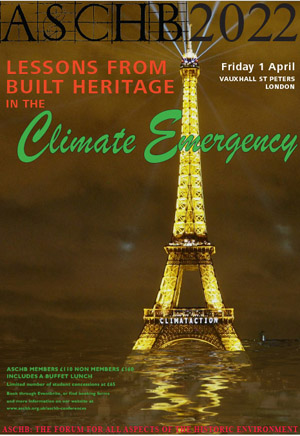

ASCHB 2022 CONFERENCE
FRIDAY 1 APRIL 2022
VAUXHALL ST PETER’S
310 KENNINGTON LANE LONDON SE11 5HY
Coffee and registration from 8:30; Conference from 9:15 until 17:00
BOOKING ON EVENTBRITE HAS NOW BEEN EXTENDED TO 7.00pm 30 MARCH
The climate emergency is with us now. It threatens our very existence; and to meet the challenge we shall have to change how we build and operate our buildings. The historic environment is often labelled the villain in the race towards a more sustainable future, but as conservation professionals know, it is arguably our most valuable resource.
The 2022 ASCHB conference will aim to draw lessons from heritage, viewing the historic built environment not as a problem, but as a critical part of the solution. It will look at familiar problems with new eyes:
- The pursuit of ‘net-zero’: what does this really mean, and why is it important? How can our built environment be modified to meet carbon targets, and how do we assess where we are and where we are going?
- Adaptation to overheating, flooding, storms and other weather extremes: can this increase the lifespan and useability of buildings, but simultaneously cut carbon?
- What can the design and use of pre-Industrial buildings and landscapes teach us? Our built environment changed dramatically when we began to burn fossil fuels on an industrial scale. How do we disentangle the many real advances of the industrial age from the myriad changes that have reduced building lifespans, are energy-hungry and belch carbon?
- How have changes in policy, regulation and assessment affected the way we design, construct and use our buildings?
In posing these questions we seek to lay down some foundations for a practical new vision for the future: an interdisciplinary vision that combines the best of both modern and historic technology and practices, avoids maladaptation, and embeds learning and education, so that lessons are learnt and wisdom is passed on.
This is a vision which places the users of the built environment once again at the centre of decisions.
See the programme below for our speakers.
Come to ASCHB2022, join the debate, and be part of the solution!
ASCHB MEMBERS £110 NON-MEMBERS £160
includes a buffet lunch, morning and afternoon tea
A limited number of student concessions are available at £65: please contact the Conference Administrator
To book, go online to and follow the link to our Eventbrite page: https://2022-aschb-conference-climate-emergency.eventbrite.co.uk (please note that Eventbrite charges a small booking fee)
Alternatively, you can fill in a booking form and send it together with your payment to the Conference Administrator.
The booking form can be downloaded HERE
The flyer can be downloaded HERE
The booking form is also available in hard copy from the Conference Administrator.
ASCHB CONFERENCE ADMINISTRATOR:
9 Wearside Road
London SE13 7UN
email: information@aschb.org.uk
CONFIRMED PROGRAMME
Download the programme HERE
| 8:30 | CHECK IN OPENS | Vauxhall St Peter’s 310 Kennington Lane London SE11 5HY |
| 9:20 | Welcome and introduction to the day | Chair: Jean Letherby |
| 9:30 | SESSION 1: SETTING THE SCENE | |
| KEYNOTE | Carl Elefante | |
| The landscape for professionals | Morwenna Slade | |
| 10:00 | SESSION 2: MITIGATION & ASSESSMENT | Chair: Robyn Pender |
| Investigating the historic environment at Hardwick Hall | Ranald Lawrence | |
| Heritage residents in reality | Freya Wise | |
| 10:45 | Morning Tea | |
| 11:25 | Why embodied carbon is important (and how heritage buildings have got it reight all along) | Alice Moncaster |
| The circular economy and long life-span buildings | Adala Leeson | |
| 12:00 | Questions for morning speakers | |
| 12:30 | Lunch | |
| 13:30 | SESSION 3: ADAPTATION | Chair: Morwenna Slade |
| Buildings in use: discomfort, and what can be done about it | Sarah Khan | |
| Planning for the future of Winchester Cathedral | Charlotte Robinson | |
| Flooding and the urban environment | Joanne Williams | |
| 14:50 | Afternoon Tea | |
| 15:15 | SESSION 4: THE WAY FORWARD | Chair: Richard Woolf |
| The trajectory towards an industry standard | Jess Hrivnak | |
| ENDNOTE: Retrofit our buildings, or our brains? Changing mind-sets for the Climate Emergency | ||
| 16:30 | PLENARY | Chair: Sherry Bates, ASCHB Chair |
| 17:00 | CLOSE |
ASCHB 2021 AGM
Our fifty-first Annual General Meeting will be held online through Zoom on 21st September 2021 at 6pm.
ASCHB CONFERENCES
ASCHB 2020 AGM & Conference Conserving Knowledge:
Recording & archiving the historic environment for future generations.
FRIDAY 6 MARCH 2020 at The National Archives, Kew, Richmond TW9 4DU
Our ASCHB 2020 proved a very successful event with many expressions of appreciation for the speakers, organisation and venue. A more detailed report will follow shortly.Dr Philippa Turner, Sector Development Manager, London & Business Archives at The National Archives, explained that creation and holding of conservation archives was not just the recording of projects, but her remit covered the businesses themselves who were involved in the project.As promised she has sent us a list of the links to Resources and Guidance from The National Archives, and to other resources, she mentioned in her talk:Resources from The National Archives Guidance from The National Archives Links to Other ResourcesDownload the list hereThe Themes of the Conference
What do we choose to record, why, and for whom? What is not being recorded and could be lost to the future? The ASCHB 2020 Conference investigates all these issues, examining not just traditional methods of recording but also new technologies and contemporary archiving practices.We will be at the stunning home of the UK’s records, The National Archives at Kew. Hear papers from a wide variety of eminent practitioners whose work in this field has developed alongside the emerging new technologies.Speakers Peter Guillery, Joe Thompson, Alexandra di Valmarana, Carl Brookes, James Hepher, Tobit Curteis, Philippa Turner and Julian Harrap will consider serving not just artefacts but digital material, and reflect on the challenges involved in delivering the perfect archived record. Chairing the proceedings will be Jean Letherby and Ingval Maxwell.Come to ASCHB 2020 and join in the debate!ASCHB MEMBERS £110 NON-MEMBERS £145
Students on undergraduate and postgraduate courses and those serving apprenticeships are eligible for discounted places at £65 which just covers the venue costs. Please confirm your student status when booking.Download a booking form here Places can also be booked through Eventbrite, who make a charge for their service, at https://2020aschbconference.eventbrite.co.ukFurther information can be found by clicking to download our poster , flyer and programmeAGM registration begins at 9.00, with the AGM from 9:15-9:50. You can download AGM paperwork here, links updated: 2020 AGM agenda, 2019 AGM minutes. Please download the discussion paper for a proposed increase in subscriptions here Coffee and Conference registration will be from 9:30, with the Conference from 10:00 until 17:00.Networking opportunities with the speakers and fellow delegates will be built into the day. CPD certificates will be supplied on request.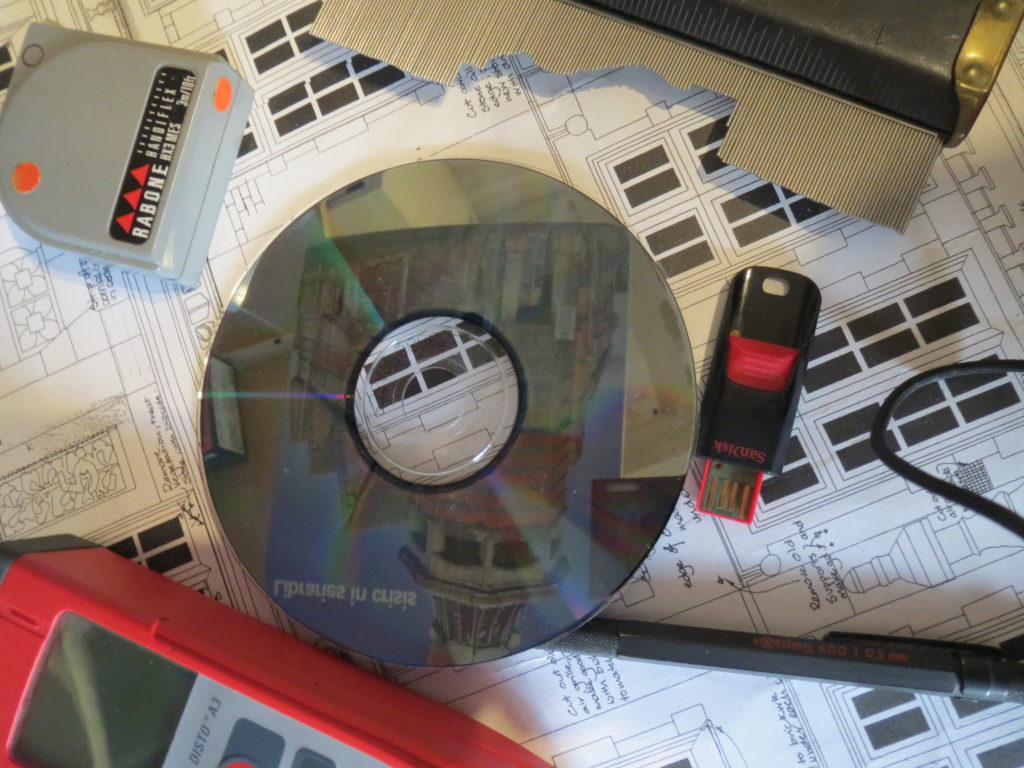
ASCHB Annual Conference 2019: MILLS AND BOOMS
The Conservation of Industrial Archaeology, Buildings and sites in Industrial Use
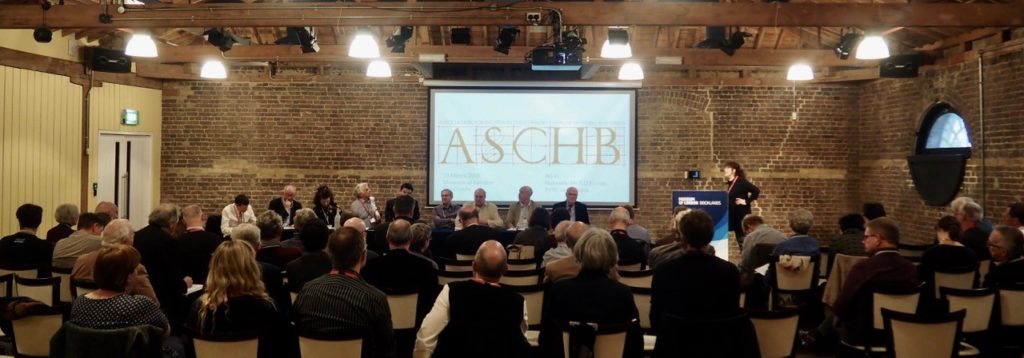
ASCHB Annual Conference 2019
The Association for Studies in the Conservation of Historic Buildings annual conference was held at the Museum of London Docklands on 15th March. It was attended by more than 75 delegates from many different areas of building conservation and all with an interest in industrial archaeology and a wish to tap in to the expertise of the eminent line-up of speakers. The venue in the heart of London’s docklands added to a day dedicated to exploring issues involved in dealing with industrial buildings and their equipment once their original functions have ceased. There are many challenges and many responses: ‘conserve as found’, adaptive re-use, interpretation to the public as an historic site, to name but a few.
After a welcome from Sherry Bates, chairman of the association, Shane Gould, Historic England’s Head of Industrial Heritage Strategy, kicked off the day by reminding us of the significance of mills with the diversity of their heritage value and the ways their future can be assured. Some can be preserved as working heritage attractions, sometimes supported by the Arts Council, some become subject to demolition as part of an over-arching strategy for regeneration. Shane expressed his concern about the lack of university-based learning in this field. Many architects, surveyors, town planners and structural engineers pick up the knowledge as they work if they can get into the right roles in the right organisation and take advantage of opportunities offered. Next up was Michael Nevell, Head of Archaeology at the University of Salford. He shared with us the studies of Michael Rix on the growth of industrialisation with the accompanying domestic building developments to house the influx of workers in the 50s, 60s, and 70s. He drew our attention to industrial buildings that can become stunning sites able to grab the public’s attention in their new life.
Henrietta Billings chaired the second session which she introduced with reference to Wentworth Woodhouse, a Palladian and baroque house with an extraordinary wide façade which was subject to open-cast mining right up to its back door in the post-war need for coal. Next up was David Went, a landscape archaeologist and senior investigator at Historic England. His contribution focussed on Elsecar, an iron and coal village in Barnsley’s heritage zone. In the 1850s Earl Fitzwilliam encouraged the mining, bringing in a canal and developing back-to-back housing for the workers, generously proportioned villas for the managers and a church for worship. Mining finally ceased in 1983 but the area had been designated as a conservation area in 1974. Their furnaces supplied the iron plates for HMS Warrior! John Tanner, director of Great Place Wentworth and Elsecar project and he brought together a number of sites of interest in Yorkshire. He is passionate about huge efforts being made to get the interpretation of industrial sites comprehensible as many sites are very complex and unless care is taken people are confused not inspired!
We then all had a very nice lunch and took the opportunity to network with old friends and new acquaintances. Charles Wagner took the chair for the first afternoon session and without more ado introduced the first of a series of case studies. Malcolm Tucker is a caseworker for the Greater London Industrial Archaeology Association and he has been documenting the London Docklands since the 60s. A lot of the ‘regeneration’ of the docks has come at the expense of the heritage of the area. St Katherine’s dock was closed in 1968 and turned into flats, the hydraulic ‘jiggers’ had to be disposed of and the North Stacks whose wooden stanchions were a feature were demolished in 1979. An interesting fact was that as sugar became a regular commodity in the docks cast iron stanchions were needed as sugar is so heavy. A cast iron swing bridge which was purpose built in 1820 was removed and then stolen in 1976! Parts of the docks which had traded in wine, tobacco and skins were turned into retail-spaces but this was an expensive failure. In Wapping the high Customs Wall was retained while demolition took place behind, some cranes and in particular a Scotch derrick were retained until Boris Johnson was London Mayor! We then moved to Shrewsbury for a contribution from Nick Hill, an architectural historian working for Historic England and in charge of the Shrewsbury Flaxmill Maltings which were taken over by English Heritage in 2005 when Neil Cossens was chairman. It is a ‘flag ship’ rescue, it was the first iron framed building in the world – the fire-proof Ditherington Mill was innovative in its time and its mission for the future was transformative “Live, work, learn and enjoy”. Following on was Stephen Clarke, a chartered accountant who specialises in regeneration projects and is a trustee of the United Kingdom Buildings Preservation Trust. In this role he has been instrumental in saving Middleport Pottery, the oldest continuously working china factory whose transformation used new technologies, created jobs, regenerated its community and is now an attraction which welcomes 40,000 visitors a year.
To give a wider perspective the last session of the day was given by Paul McMahon a conservation architect at the Office of Public Works in the Republic of Ireland. He talked about the ‘brown fields of Ireland’ and concentrated on the rapidly changing environment of Dublin Docks and how this is governed by State Protection in the form of the National Monuments Act, The Archaeological Survey and the Record of Monuments and Sites all ratified by the Granada Convention in 1997. In addition local protection depends on the National Inventory and the record of Protected Structures. His position is an advocacy role ensuring capacity building, skills development and provision of CPD is available for all conservation professionals. Sustainable development is key together with adaptive re-use whose success contributed to Dublin’s European Year of Culture.
Providing the end-note was Sir Neil Cossens whose eminence in the field of industrial heritage is legendary. He reminded us that in the UK there is a passion for historic buildings and maybe we are on the cusp of an even greater interest in industrial archaeology. Skansen in the heart of Stockholm was the inspiration for more than 300 open air museums which all feature industrial, agricultural and domestic exhibits. The Henry Ford Museum in USA pays homage to industrialisation, when Ford visited London and saw Stephenson’s Rocket in the Science Museum he wanted to buy it and when told “no” he had five built to exhibit in America! The 2000 publication ‘Power of Place’ discussed the cyclical nature of public interest in heritage and how some projects become ‘orphans’ as a result of negligence. Neil mused that we are approaching a new golden age where industrial landscapes are valued by their communities and are part of their culture and this can be ‘the manure which fertilises the future!’
